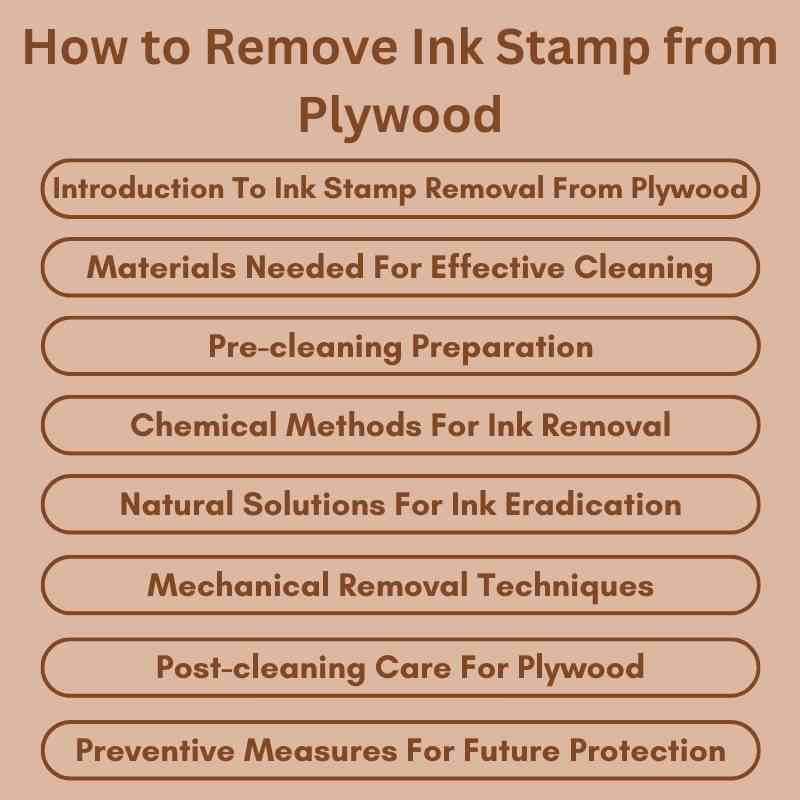To remove an ink stamp from plywood, use rubbing alcohol or acetone on a cotton ball. Gently rub the stain until it fades, then clean the area with water.
Ink stamps can be a nuisance on plywood surfaces, especially if they mar the natural beauty of the wood. Stamps often leave behind stubborn marks that can be difficult to eliminate. Homeowners and DIY enthusiasts often seek effective solutions to restore their plywood’s appearance.
Using the right techniques and materials can help you achieve a clean surface without damaging the wood. This guide will provide clear steps to safely remove ink stamps from plywood. Whether you’re prepping for a new project or simply maintaining your wood, these methods will help ensure a successful outcome.
Introduction To Ink Stamp Removal From Plywood
Removing an ink stamp from plywood can be tricky. Many people face common challenges during this process. Stamps can leave behind stains and residue. Sometimes, the wood gets damaged if not handled properly.
Before starting, take safety precautions. Always wear gloves to protect your hands. Use goggles to shield your eyes from chemicals. Work in a well-ventilated area to avoid inhaling fumes. Keep children and pets away from the workspace.

Materials Needed For Effective Cleaning
To effectively clean ink stamps from plywood, gather these materials:
| Essential Cleaning Agents | Tools for the Job |
|---|---|
| Rubbing alcohol | Soft cloth |
| Acetone | Plastic scraper |
| Dish soap | Paintbrush |
| White vinegar | Old toothbrush |
Gather these items before starting your cleaning task. Having the right tools makes the job easier. Ensure all materials are safe for your plywood surface.
Pre-cleaning Preparation
Start by removing dust from the plywood surface. Use a soft cloth or a vacuum with a brush attachment. This prevents scratches during the cleaning process.
Next, protect the surrounding area. Use drop cloths or newspapers to cover nearby surfaces. This helps avoid any mess from cleaning products. Make sure to secure the covers with tape if needed.
Gather all the necessary tools and products. Have rubbing alcohol, cotton balls, and gloves ready. These items will help in safely removing the ink stamp.
Chemical Methods For Ink Removal
To remove ink stamps from plywood, acetone is a great choice. Apply a small amount on a cloth. Gently rub the stained area in a circular motion. This can help lift the ink without damaging the wood.
Alcohol-based solutions can also be effective. Use rubbing alcohol or hand sanitizer. Soak a cotton ball with the solution and press it on the ink. Let it sit for a few minutes before wiping it away.
Always test these solutions on a hidden spot first. This ensures that the finish on the wood remains intact. Keep the area well-ventilated while working. Safety is important when using these chemicals.
Natural Solutions For Ink Eradication
To remove ink stamps from plywood, lemon juice and baking soda work well together. Mix equal parts of lemon juice and baking soda to form a paste. Apply this paste on the ink stain and scrub gently. Rinse with water after a few minutes. This method is safe and natural.
Another option is vinegar. Soak a cloth in vinegar and place it on the ink stain. Let it sit for about 10 minutes. Then, gently scrub the area with a soft cloth. Rinse with water afterward. Vinegar is a great alternative for removing stubborn stains.
Mechanical Removal Techniques
Sanding is an effective way to remove an ink stamp from plywood. Use fine-grit sandpaper for best results. Start sanding gently to avoid damaging the wood. Work in small circles over the stamped area. Clean the surface with a damp cloth after sanding.
Scraping can also help, but there are important tips to follow. Use a sharp scraper to avoid tearing the wood. Always scrape in the direction of the grain. Don’t apply too much pressure, as it may leave marks. Avoid using metal scrapers on softwood, as they can cause damage.
Post-cleaning Care For Plywood
After cleaning the plywood, neutralizing chemicals is essential. Use a solution of water and vinegar to balance the PH. This helps prevent any damage. Apply this mixture gently with a soft cloth. Rinse the area with clean water afterward.
Conditioning the wood is important for its longevity. Choose a quality wood conditioner or mineral oil. Apply a thin layer using a clean cloth. Allow the conditioner to soak in for at least 15 minutes. Wipe off any excess with a dry cloth. This keeps the plywood healthy and looking great.
Preventive Measures For Future Protection
To protect plywood, sealing is key. Use a good quality sealant to cover the surface. This helps prevent stains from ink stamps.
Regular maintenance is important. Check the surface often for wear and tear. Clean it gently with a damp cloth. Avoid harsh chemicals that can damage the seal.
Consider applying a new coat of sealant every 1-2 years. This keeps the plywood looking fresh. Keep it away from direct sunlight to avoid fading.
Troubleshooting Common Issues
Stubborn ink stamps can be hard to remove. Use a soft cloth and rubbing alcohol to start. Gently blot the stamp area without scrubbing. This helps lift the ink without damaging the wood.
If the stamp remains, try a mixture of baking soda and water. Make a paste, apply it to the stamp, and let it sit for a few minutes. Afterward, wipe it away gently.
Cleaning might cause some damage to the plywood surface. To repair, use a wood filler to fill in any scratches. Sand the area gently until smooth. Finish with a matching wood stain to blend the repair.
Conclusion: Best Practices Recap
Removing ink stamps from plywood can be simple with the right methods. Start by using a soft cloth and rubbing alcohol. Apply the alcohol gently to avoid damage. Rubbing in a circular motion helps lift the ink. A magic eraser can also work wonders. Test it on a small area first.
For stubborn stamps, consider sandpaper. Use fine-grit sandpaper to carefully rub away the ink. This technique may leave marks, so touch up the surface afterward. Always finish with a wood finish to protect the plywood.
Regular care is essential for plywood. Keep it clean and dry to prevent future stains. Use coasters and mats to protect surfaces from ink. Following these tips ensures your plywood remains beautiful and lasting.

Frequently Asked Questions
How Can I Safely Remove Ink Stamp From Plywood?
To safely remove an ink stamp from plywood, first gather supplies like rubbing alcohol, a cloth, and a soft brush. Dampen the cloth with alcohol and gently rub the inked area. Avoid excessive moisture to prevent wood damage. Wipe clean and allow to dry thoroughly.
What Household Items Can Remove Ink From Wood?
Household items like rubbing alcohol, vinegar, and baking soda can effectively remove ink from wood. Apply rubbing alcohol on a cloth and dab the stained area. For vinegar, mix it with baking soda to form a paste. Apply gently, and wipe clean to restore the plywood’s appearance.
Is It Safe To Use Acetone On Plywood?
Using acetone on plywood is risky. Acetone can strip paint and damage the wood’s finish. If you choose to use it, test it on a small, inconspicuous area first. Always ensure proper ventilation and consider gentler alternatives like rubbing alcohol for safer results.
How Do I Prevent Ink Stains On Plywood?
To prevent ink stains on plywood, apply a protective sealant or finish. This creates a barrier against moisture and stains. Always use coasters and placemats when working with ink. Regular maintenance and cleaning also help keep the surface in pristine condition.
Conclusion
Removing an ink stamp from plywood can be straightforward with the right techniques. Whether you choose solvents or gentle scrubbing, always test in a hidden area first. Patience is key to avoid damaging the wood. With these tips, your plywood can look as good as new, free from unwanted marks.

